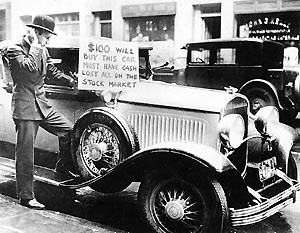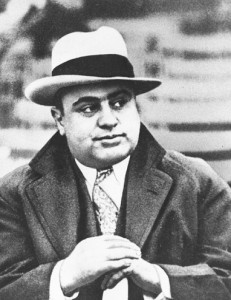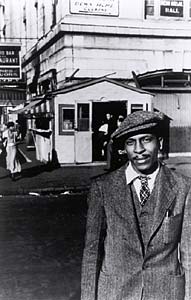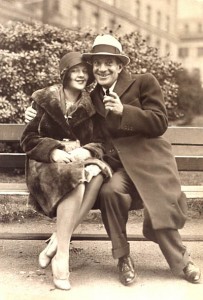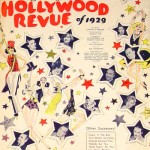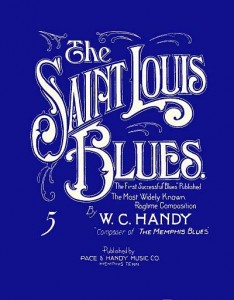In 1929 jazz was making its way into mainstream America, moving from Chicago to New York, blossoming in Harlem nightclubs, on the Broadway stage and in New York studio sessions. Everyone remembers 1929 for the Wall Street crash that launched the Great Depression, yet for most of the year the economy wasn’t what people were talking about.
With Prohibition the law of the land, nightspots everywhere needed gangland connections for a steady supply of illegal liquor. The FBI tagged mobster Al Capone "Public Enemy Number One." Rival gangs warred for control of the bootlegging rackets, but the events of February 14, 1929 in Chicago crossed the line—the 1929 Saint Valentine’s Day Massacre. No one doubted that Al “Scarface” Capone had ordered the hit, though he never went down for it. His target was assumed to be rival bootlegger “Bugs” Moran. Crime-fighter Elliot Ness led a crackdown, and a few years later Capone was in jail for tax evasion.
Jazz in Harlem
The brutal New York mobster Dutch Schultz, the city’s "beer baron," had a stake in the Harlem nightclub Connie’s Inn. Rubbing shoulders with mobsters was just a part of life for songwriters like Fats Waller and Andy Razaf.
Razaf was a prince from Madagascar. But upon arrival in America he was just another Negro, and treated accordingly. He was working on a new show called Hot Chocolates. The money had been put up by Schultz. During the previews Schulz told Andy Razaf to write a funny song for a colored girl, about how difficult it is being colored. After Razaf refused him Dutch Schulz slammed him up against the wall, cocked pistol pressed to his skull and said, “You will write the song, boy.”
The result was a brilliant subterfuge. Razaf's lyric to "What Did I Do to Be So Black and Blue?" was later adopted as a racial protest song:
Brown and yellows / All have fellows Gentlemen prefer them light
Old empty bed / Springs hard as lead Feel like old Ned / Wish I was dead All my life through I've been so black and blue
Even the mouse / Ran from my house They laugh at you / and scorn you too What did I do to be so black and blue?
I'm white inside / But that don't help my case 'Cuz I can't hide / What is in my face
How will it end / Ain't got a friend My only sin / Is in my skin What did I do to be so black and blue?
1929 Jazz Tunes on Broadway
The Gershwin musical Show Girl turned out to be a flop of the 1929 Broadway season; even though it had a strong cast and score—plus the added notoriety of Duke Ellington conducting his Cotton Club Orchestra as part of the production. But the Gershwins often managed to revive songs from the ashes of shows that didn’t make it. Their tune "Liza," composed for leading lady Ruby Keeler, got a jump start the night Show Girl opened. Keeler’s newlywed husband, Al Jolson, flew in from Hollywood for the opening and blew everyone away when he hopped up on stage from the audience and sang a chorus of "Liza" to his bride.
Jolson’s stunt caused a sensation and "Liza" became a favorite with jazz musicians, including Benny Goodman, Chick Webb and Art Tatum. Today the tune ranks among the top 200 most-frequently-recorded jazz standards of all time. The Jim Cullum Big Band offers their rendition of "Liza."
By 1929 Jerome Kern was the patriarch of American musical theater and he had another hit on his hands that year with Sweet Adeline and a song from that show, "Why was I Born?" performed on our broadcast by The Jim Cullum Jazz Band.
Jazz on the Silver Screen
Germany scored a coup in 1929 with the first round-the-world flight of their Zeppelin airship. On the other hand, a talking mouse helped America make its contribution to the world—Walt Disney’s Mickey Mouse had his first speaking role and Popeye, the Sailor Man made his debut. MGM’s Hollywood Revue of 1929 delivered a lavish production to the screen with everything from comedy stars like Jack Benny and Buster Keaton to a scene from Romeo and Juliet. The enduring hit to come out of the Hollywood Revue would be re-introduced by Gene Kelly a couple decades later. On our show, Joe Williams does the honors on "Singin' in the Rain."
The Crash
The 1920s had been a decade of skyscrapers, skywriting and "the sky’s the limit." It saw the birth of broadcasting, the recording industry and advertising. More people had more money and more fun than ever before, until it all came tumbling down.
Billions of dollars of wealth were wiped out in a single day—Black Tuesday, October 29th, 1929. Panic set off a worldwide run on the dollar, and led to the failure of some 4,000 banks. The nation, stunned and in mourning, would not fully recover from the Great Depression that followed until the coming of the Second World War once again filled the factories, mines and fields of America.
Topsy Chapman sets the tone with her rendition of "St. Louis Blues," in tribute to Bessie Smith, who made her movie debut (and only film appearance) in 1929, in the two-reeler, St. Louis Blues. And Jack Teagarden and Louis Armstrong make their first recording together in 1929, a bluesy number called "Knockin' a Jug."
Photo credit for Home Page: Louis Armstrong, cir 1929. Image courtesy flickr.
Text based on Riverwalk Jazz script by Margaret Pick ©2012


